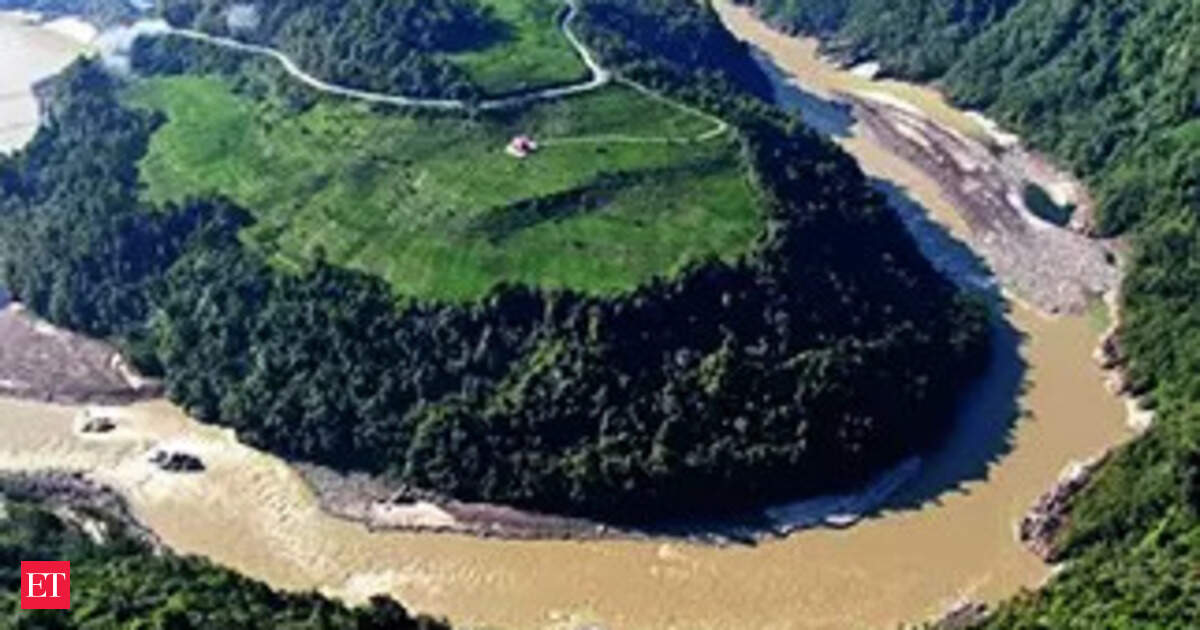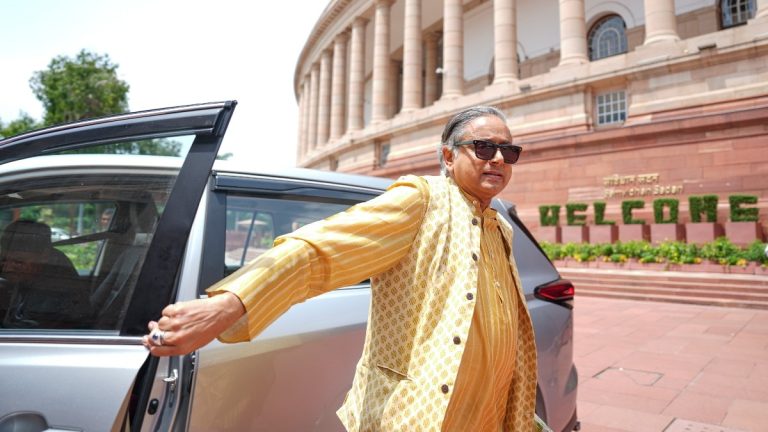On the Big Take Asia Podcast, host Menaka Doshi speaks to Bloomberg’s Dan Murtaugh about the engineering and geopolitical challenges, and the impact construction will have on the country’s economy.
Here is a lightly edited transcript of the conversation:
Menaka Doshi: Earlier this month, China officially started construction on a massive hydropower dam in Tibet.
CCTV news anchor (in Chinese): Li Qiang announced the start of the hydropower project in the lower reaches of the Yarlung Tsangpo river, and the construction of the project officially kicked off.
Doshi: The dam, when completed, will be the biggest power plant on the planet.
Dan Murtaugh: It’s three times bigger than the largest power plant in the world right now. It’s more than all of the power plants in Poland combined.
(Dan Murtaugh covers the energy industry for Bloomberg from Beijing.)
Murtaugh: The amount of cement they’re estimating they’ll need, it would be enough to fill more than 50 Hoover dams. And the amount of steel, it’d be enough to build 116 Empire State buildings.
Doshi: This mega project comes with a mega price tag – $167 billion.
Murtaugh: This would be one of the most expensive undertakings for infrastructure in human history. More expensive than the International Space Station. You’re looking at, you know, decades-long projects like building the US interstate highway system before you get to comparable amounts of investment.
Doshi: China says the dam will provide a major source of clean energy. More importantly, it will boost the country’s slowing economy. But the project carries huge engineering and environmental risks and could strain relations with two of its neighbours, India and Bangladesh.
Murtaugh: The Indian government has been worried about, if China was able to build a dam, they would then be able to use sort of water access as a pain point if there was an eventual conflict between the countries. And there’s gonna be all of this human activity in a place that’s been remote for most of its history. You hope for the best, but human history has not been very kind to planet Earth. And you just have to wonder if they’re gonna be able to, to reign in people from not damaging permanently this really unique area.
Doshi: This is the Big Take Asia from Bloomberg News. I’m Menaka Doshi, filling in for Oanh Ha. Every week we take you inside some of the world’s biggest and most powerful economies, and the markets, tycoons and businesses that drive this ever-shifting region. Today on the show — China bets big on a new mega dam. Why the project is raising alarm with its neighbours, and what its construction could mean for China’s economy and its green energy ambitions.
Doshi: When it comes to building hydrodams, China’s got plenty of experience. It operates two of the world’s largest dams. That includes the world’s biggest hydrodam – Three Gorges – which opened in central China in 2009. This new mega dam will be built in Tibet, a mountainous region just north of the border with India.
Murtaugh: It’s in this bend on the Yarlung Tsangpo River that they call the Mêdog or Motuo gorge.
Doshi: And Bloomberg energy reporter Dan Murtaugh says the dam is in an area that till recently was very difficult to get to.
Murtaugh: It is a very, very, very steep drop. The river drops about 2,000 meters over a 50 kilometer stretch as it curves and bends through the mountains of the Himalayas. The county that it’s at is up until 2013 didn’t even have a highway that connected it. You’d have to walk a day, you know, or, or take a donkey or a horse to get to the river from the closest highway.
Doshi: Most dams – like the Hoover dam – block the path of a river to create a reservoir. They then release the water, which turns turbines, and generates electricity. This Yarlung Tsangpo dam is different.
Murtaugh: What they’re trying to do here is a little bit more audacious. The idea is to drill a tunnel through the mountains down the steep, steep, steep gradient, and then divert some of the water from going around that big bend and instead go basically just vertically straight down the mountain. That steep gradient that this river moves on really allows you to get that water flowing at high enough speeds to be able to run the turbines to generate the electricity.
Doshi: At the groundbreaking ceremony earlier this month, Chinese Premier Li Qiang called the Yarlung Tsangpo dam the “project of the century.” State engineers have said it has the potential to generate as much as 70 gigawatts of electricity. That’s enough to power the United Kingdom.
Murtaugh: It’s three times bigger than the largest power plant in the world right now. It is a national country level type of a generating asset. But China’s huge. China has about 4,000 gigawatts of total generating capacity right now. Its peak demand is about 1,450 gigawatts. And so this project isn’t going to have a huge world-changing impact on China’s power sector. But it does do a couple of different things that are gonna be really beneficial to China’s attempt to clean up its energy sector and will help China meet its energy transition goals of peaking emissions by 2030, and then reaching net-zero emissions by 2060.
Doshi: China still relies on coal-powered plants to back up its more sustainable energy sources like solar and wind.
Murtaugh: Wind and solar, while cheap and while abundant, only generate when the wind blows and it doesn’t really allow them to replace coal plants because at the end of the day you still need, you know, backup generation to make sure that when there’s a period where there’s no sun out and the wind stops, that people can still turn on their lights. What hydropower does that wind, solar don’t do is it’s what we call, uh, a dispatchable source. You can use it when it’s needed. You can hold it back when it’s not. Now hydropower is not perfectly dispatchable. Like if you are using a fossil fuel power plant, a gas or a coal power plant, you can really just sort of turn it off and on as needed. Hydropower, there’s still some external things like whether there’s a drought, if there’s, you know, too much water, there’s rain, you know, you have to open the floodgates. It’s not perfect, but it is a clean power source that allows the grid to be a little bit more flexible in terms of, you know, generating when it’s needed and not just, when the supply’s available.
Doshi: That reliability and flexibility are just two of the reasons why building a hydroelectric dam is so expensive. The Yarlung Tsangpo dam will cost $167 billion – more than the International Space Station did. And Dan says, the power it generates will be several times more expensive than any other energy source.
Murtaugh: If it ends up being about a 70-gigawatt project as we expect it to be, you’re talking about $2.4 million per megawatt. Now that compares to, an onshore wind plant right now that China would spend about $600,000 per megawatt on, or a solar power plant that China would spend about $400,000 per megawatt on. China infrastructure projects never lack for lenders, but this is not a white elephant. This is gonna be a hydropower project that sells a lot of electricity, that electricity has value. And so they’re gonna be able to go to their lenders and say, listen, over 20, 30 years, we’re gonna make a ton of money and we’re gonna have the revenue to pay you back.
Doshi: Dan says there’s another reason the Chinese government has greenlit the project – and that’s the state of China’s economy.
Murtaugh: The way I think about it is, this is less of a hydropower project that’s gonna provide some economic stimulus and more of an economic stimulus project that at the end of the day we’ll be able to produce some hydropower. We’re in this new sort of era where China’s economy has been stagnant since COVID. People have been waiting for a kind of stimulus boost to recover it. Sectors like cement, like steel, like construction, those have been particularly hard hurt by the burst of the property bubble. And so you’ve got this perfect storm here where there’s this project that requires a lot of those materials that used to be seen as maybe a little bit risky and, and costly to do, but now it kind of fits this dual need of both providing some economic stimulus for some hurting sectors, while also eventually providing a really, really large source of clean energy.
Doshi: The project is estimated to generate 200,000 new jobs and boost China’s GDP every year for the next decade.
Murtaugh: They’ve estimated that it’s likely bigger than multiple different monetary policy actions that the central bank has taken over the past few years. Uh, so it could really help reflate the economy as they try to do their supply side reform over the coming years.
Doshi: How China plans to transmit all that clean energy — and what the dam’s construction means for simmering tensions between Beijing and New Delhi — that’s after the break.
China has been talking about building a mega dam on the Yarlung Tsangpo river for decades. But construction was approved only in December last year. Bloomberg’s Dan Murtaugh says that’s largely because the challenges to the project are so formidable.
Murtaugh: In past conversations I’ve had with people, they were a little bit, iffy on whether it would ever get built because this is an incredibly remote site. It’s very, very far away from any major population centers. And so, you have to transport millions of tons of cement and sand and aggregate and tens of thousands of workers up to this remote area.
Doshi: The project site is in a seismically active area. That means engineers will need to ensure that the dam is strong enough to withstand earthquakes. And then there’s the question of how to get the power generated by the dam to the places that need it — Beijing. Shanghai. Hong Kong – They’re all thousands of miles away. Which means this isn’t just one massive infrastructure project: It’s two.
Murtaugh: Earlier this year when China uh announced this project as part of their work plan for this year, they not only said we’re gonna try to develop hydropower in the Yarlung Tsangpo river, but they said we’re gonna try to build a power line from Tibet to the Hong Kong, Guangzhou, Shenzhen Bay area to transmit some of that. That itself is gonna be a major undertaking, it’s gonna require lots of copper and aluminum and steel itself. Citibank has estimated just the transmission alone could be another 700 billion yuan, about a hundred billion dollars. And so that will also be a difficult thing.
Doshi: The domestic considerations in building this mega dam are considerable. But they might be overshadowed by international complications. Downstream from the site, the Yarlung Tsangpo river flows into India, and then into Bangladesh, and is critical to livelihoods in the region.
Murtaugh: When China first announced back in December that they was gonna go forward with this, the Indian government reached out to the Chinese government. They raised alarm bells. They, uh, an Indian minister said in March that this was part of discussions the country’s had in January. The Chinese government clearly thinks that they’ve told the Indian government, the downstream areas won’t be affected. And they think that they’ve convinced Indian officials that, this is not a project that will harm the ties.
Doshi: The relationship between China and India has worsened in recent years after a long history of border disputes in the Himalayan region.
Murtaugh: It is too early to say how this is gonna develop. Already, India has mooted building its own hydropower station across the border from this plant where they would be able to at least put in a little bit of their own control over the flow of the water and produce their own electricity.
Doshi: There’s another complication – Tibet is a highly sensitive area. The region has long endured intense social, security, and religious controls under Beijing’s policies. And though China has denied them – allegations of mass labor systems and political repression persist.
Murtaugh: Tibet is a politically sensitive area. It’s been in the sort of global crosshairs for decades. Tibet and and the Beijing government have a very long and fraught history. And, you know, frankly, as a foreign journalist, Tibet is an area that I’m not allowed to visit.
Doshi: It’s not just the political situation in Tibet, there are significant concerns around the environmental implications as well.
Murtaugh: This is a really, really fragile area. It’s a really unique, there, you know, you have this dry mountain air coming down from the Himalayas, meeting up with this, humid, uh, warm air coming up from the Indian Ocean. It’s one of, you know, the most uniquely biodiverse spots in the world, and the idea of bringing tens of thousands of workers plus however many, tens if not hundreds of thousands more, will sort of pop up to create like the restaurants and food trucks and bars and karaoke and stuff to, to service these people. The idea that there’s gonna be all of this human activity in a place that’s been remote for most of its history. You hope for the best, but human history has not been very kind to planet Earth. And you just have to wonder if they’re gonna be able to, to reign in people from not damaging permanently this really unique area.








